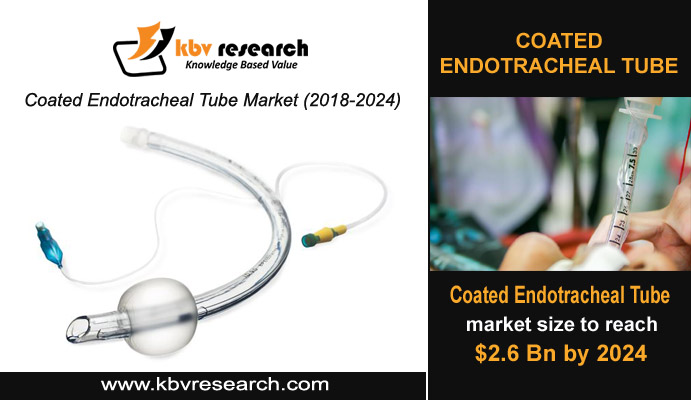
The up surging procedures owing to the increasing chronic respiratory diseases like cardiovascular ailments, diabetes, cancer, and so forth, are pushing the adoption of coated endotracheal tubes. The need for ventilator-associated pneumonia and geriatric population are growing significantly; thereby, contributing to the growth and developments in coated endotracheal tubes.
The endotracheal tube is a metal or plastic tube which is introduced in the trachea through the mouth or nose. The tube validates the sufficient exchange of oxygen and carbon dioxide along with preserving the patient’s airway. Coated endotracheal tube has a coating of antithrombotic agents that are used for preventing clots or antibiotic agents like polyvinyl chloride, silver, and other drugs which would impede the growth of the bacteria on the surface of the endotracheal tube. In order to ensure comfort during frequent replacement of these tubes, they are treated with antibacterial agents.
Coated endotracheal tubes have numerous benefits because their coatings have a widespread antimicrobial activity in vitro. It helps in reducing the bacterial adhesion and prevents biofilm formation on the tube surface. As a result, the occurrence of a type of hospital-associated infection is blocked.
Ventilator-associated pneumonia (VAP) is an infection that might occur due to hospital visits and generally occurs in patients with mechanical ventilation. It is usually caused owing to the growth of microorganism on the surface of air management devices, which in turn causes illness. According to studies, VAP generally develops 48â€72 hours after endotracheal intubation. Therefore, it is imperative to thwart VAP infections by substituting the non-coated endotracheal tubes with coated endotracheal tubes. Endotracheal tubes coated with antibiotic agents like drugs and silver prevent the microorganisms’ growth during ventilation. KBV Research, one of the leading market research domains, recently published a report which indicated that the increase in VAP incidence will necessitate the requirement of coated endotracheal tubes, which is expected to boost the growth of the global market for Coated Endotracheal Tube over the forecast period.
The evolution of coated endotracheal tube is in par with advancements in surgery and anesthesia. Modifications were initiated to achieve many tasks such as minimizing gross aspiration, isolating a lung, or providing a clear facial surgical field during general anesthesia.
Orotracheal intubation is a process in which the orotracheal tube is inserted through the mouth. Orotracheal intubation triggers minimal pain and is an easy-to-perform process under direct laryngoscopy. Orotracheal intubation is generally used in emergency situations like a cardiac or respiratory arrest. Further possible emergency situations include insufficient oxygenation or ventilation, and airway obstruction.
Nasotracheal intubation is typically performed on patients undergoing maxillofacial surgery, dental procedures, or when orotracheal intubation is not possible. For example, in patients with restricted mouth opening. Nasotracheal intubation is a preferred route for elongated intubation in critical care units.
Click Here For Free Insights: https://www.kbvresearch.com/news/coated-endotracheal-tube-market-size/
Coated endotracheal tube market is considered as one of the most hailed business compasses of the contemporary industrial space. It has been expected to develop as a minting vertical in coming years, along with giving a picture of a palpable growth speed over the forecast period. Attempts to decrease bacterial entry through a non-coated endotracheal tube include an antimicrobial coating of the tubes.
Developments are being initiated on mechanically scraping the biofilm from within the endotracheal tube. Studies assessing the efficiency of these modifications and techniques make evident positive results. Coated medical devices are popular and proven for reducing catheter-related infections. Coated endotracheal tubes with silver sulfadiazine (SSD) are introduced to the medical ecosphere after tests in clinical studies for assessing their feasibility, safety, and effectiveness in precluding bacterial colonization.
Hospitals are purchasing endotracheal tubes from chief market players in bulk. Thus, hospitals are and will be a major contributor to the growth of coated endotracheal tubes market. Furthermore, emergence and transferal toward dedicated healthcare center might augment the ambulatory surgical centers in the coming years. The Global Coated Endotracheal Tube Market size is expected to reach $2.6 billion by 2024, rising at a market growth of 6.6% CAGR during the forecast period.